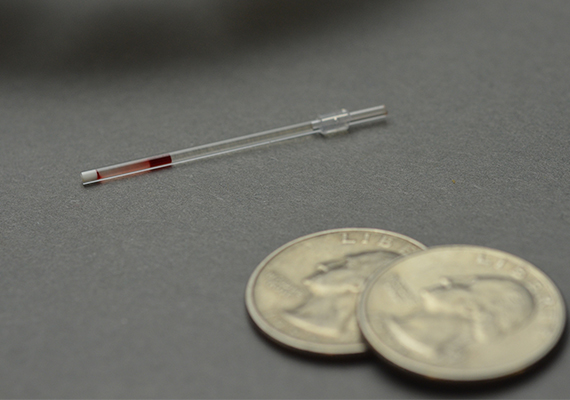From chance meeting, a chance to save lives
Physician’s advice steers researcher toward test for sickle cell disease
Within minutes after birth, every infant in the United States undergoes a battery of tests designed to diagnose a host of conditions, including sickle cell disease.
Thousands of children born in the developing world, however, aren’t so lucky, meaning many suffer and die from the illness each year.
A.J. Kumar hopes to put a halt to at least some of those deaths.
Kumar, a postdoctoral fellow who received his Ph.D. from the Graduate School of Arts and Sciences this year, worked with colleagues in the lab of Professor George Whitesides and other co-authors to develop a test for sickle cell disease that costs as little as 50 cents and provides results in just 12 minutes — far faster and cheaper than other methods. The test is described in a paper published this week in the Proceedings of the National Academy of Sciences.
“The tests we have today work great, they have a very high sensitivity,” Kumar said. “But the equipment needed to run them costs in the tens of thousands of dollars, and they take hours to run. That’s not amenable to rural clinics, or even some cities where the medical infrastructure isn’t up to the standards we see in the U.S. That’s where having a rapid, low-cost test becomes important and this paper shows such a test can potentially work.”

When run against more than 50 clinical samples — 26 positive and 26 negative — the new test showed good sensitivity and specificity for the disease, Kumar said. More extensive analysis will be needed to determine whether the test is truly accurate enough to use in the field.
The method designed by Kumar is deceptively simple, and works by connecting two ideas scientists have understood for decades.
The first is that blood cells affected by sickle cell are denser than normal cells, and the second is that many polymers, when mixed in water, automatically separate into layers ordered by density.
Conventional methods to separate cells by density have relied on layering liquids with different density by hand. The insight arrived at by Kumar and Charles Mace (now at Tufts) was that the self-forming layers could be used to separate cells, such as red blood cells, by density.
“When you mix the polymers with water, they separate just like oil and water,” Kumar said. “Even if you mix it up, it will still come back to those layers.”
It wasn’t until a chance meeting with Thomas Stossel, a physician at Harvard-affiliated Brigham and Women’s Hospital, however, that Kumar believed the technology might have a real impact on sickle cell disease.
“Initially, we started off working on malaria, because we thought when parasites invaded the cells, it would change their density,” he said. “But when I met Tom Stossel on a panel at the Harvard Medical School, he said, ‘You need to work on sickle cell.’ He’s a hematologist by training and has been working with a nonprofit in Zambia for the past decade, so he’s seen the need and the lack of a diagnostic tool.”
When Kumar and colleagues ran tests with infected blood, the results were unmistakable. While healthy red blood cells settled in the tubes at specific levels, the dense cells from blood infected with sickle cell settled significantly lower. The band of red cells could clearly be seen by eye.
Showing that the test worked was only a first step.
“We wanted to make the test as simple as possible,” Kumar explained. “The idea was to make it something you could run from just a finger prick. Because these gradients assemble on their own, that meant we could make them in whatever volume we wanted, even a small capillary tube.”
The design the team eventually settled on is barely larger than a toothpick. In the field, Kumar said, running the test is as simple as uncapping the tube, pricking a patient’s finger, and allowing the blood to wick into the tube.
Stopping even a few sickle cell-related deaths would represent a victory, he said.
“The best way to state it is in terms of the actual problem,” he said. “About 300,000 children are born every year with sickle cell disease, and the vast majority — about 80 to 90 percent — are in either Africa or India, where for the most part, they aren’t going to get access to the current screening tests.
“There were studies recently that showed in sub-Saharan Africa, between 50 and 90 percent of the children born with sickle cell disease die before the age of 5,” he continued. “Whereas in the U.S. people don’t die from this disease as children, they can still live a full life. So my hope is that if this test is effective, it can make some small dent in those numbers.”




